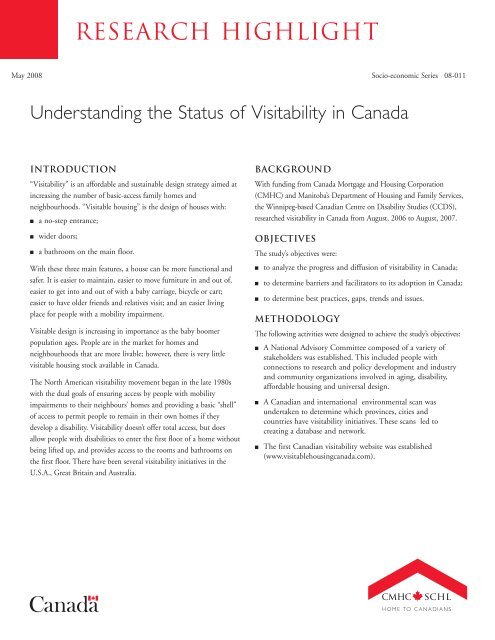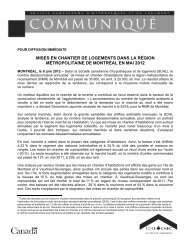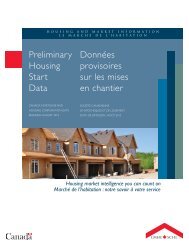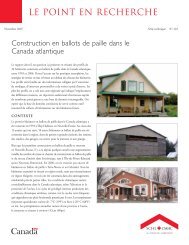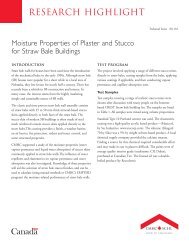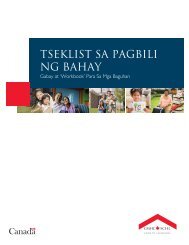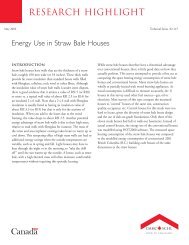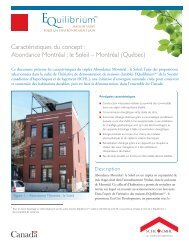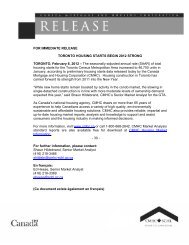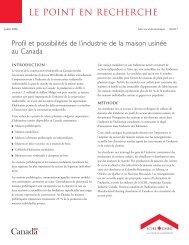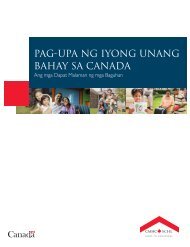Understanding the Status of Visitability in Canada - Measuring Up ...
Understanding the Status of Visitability in Canada - Measuring Up ...
Understanding the Status of Visitability in Canada - Measuring Up ...
You also want an ePaper? Increase the reach of your titles
YUMPU automatically turns print PDFs into web optimized ePapers that Google loves.
esearch highlightMay 2008Socio-economic Series 08-011<strong>Understand<strong>in</strong>g</strong> <strong>the</strong> <strong>Status</strong> <strong>of</strong> <strong>Visitability</strong> <strong>in</strong> <strong>Canada</strong><strong>in</strong>troduction“<strong>Visitability</strong>” is an affordable and susta<strong>in</strong>able design strategy aimed at<strong>in</strong>creas<strong>in</strong>g <strong>the</strong> number <strong>of</strong> basic-access family homes andneighbourhoods. “Visitable hous<strong>in</strong>g” is <strong>the</strong> design <strong>of</strong> houses with:■ a no-step entrance;■■wider doors;a bathroom on <strong>the</strong> ma<strong>in</strong> floor.With <strong>the</strong>se three ma<strong>in</strong> features, a house can be more functional andsafer. It is easier to ma<strong>in</strong>ta<strong>in</strong>, easier to move furniture <strong>in</strong> and out <strong>of</strong>,easier to get <strong>in</strong>to and out <strong>of</strong> with a baby carriage, bicycle or cart;easier to have older friends and relatives visit; and an easier liv<strong>in</strong>gplace for people with a mobility impairment.Visitable design is <strong>in</strong>creas<strong>in</strong>g <strong>in</strong> importance as <strong>the</strong> baby boomerpopulation ages. People are <strong>in</strong> <strong>the</strong> market for homes andneighbourhoods that are more livable; however, <strong>the</strong>re is very littlevisitable hous<strong>in</strong>g stock available <strong>in</strong> <strong>Canada</strong>.The North American visitability movement began <strong>in</strong> <strong>the</strong> late 1980swith <strong>the</strong> dual goals <strong>of</strong> ensur<strong>in</strong>g access by people with mobilityimpairments to <strong>the</strong>ir neighbours’ homes and provid<strong>in</strong>g a basic “shell”<strong>of</strong> access to permit people to rema<strong>in</strong> <strong>in</strong> <strong>the</strong>ir own homes if <strong>the</strong>ydevelop a disability. <strong>Visitability</strong> doesn’t <strong>of</strong>fer total access, but doesallow people with disabilities to enter <strong>the</strong> first floor <strong>of</strong> a home withoutbe<strong>in</strong>g lifted up, and provides access to <strong>the</strong> rooms and bathrooms on<strong>the</strong> first floor. There have been several visitability <strong>in</strong>itiatives <strong>in</strong> <strong>the</strong>U.S.A., Great Brita<strong>in</strong> and Australia.BackgroundWith fund<strong>in</strong>g from <strong>Canada</strong> Mortgage and Hous<strong>in</strong>g Corporation(CMHC) and Manitoba’s Department <strong>of</strong> Hous<strong>in</strong>g and Family Services,<strong>the</strong> W<strong>in</strong>nipeg-based Canadian Centre on Disability Studies (CCDS),researched visitability <strong>in</strong> <strong>Canada</strong> from August, 2006 to August, 2007.ObjectivesThe study’s objectives were:■ to analyze <strong>the</strong> progress and diffusion <strong>of</strong> visitability <strong>in</strong> <strong>Canada</strong>;■■to determ<strong>in</strong>e barriers and facilitators to its adoption <strong>in</strong> <strong>Canada</strong>;to determ<strong>in</strong>e best practices, gaps, trends and issues.MethodologyThe follow<strong>in</strong>g activities were designed to achieve <strong>the</strong> study’s objectives:■ A National Advisory Committee composed <strong>of</strong> a variety <strong>of</strong>stakeholders was established. This <strong>in</strong>cluded people withconnections to research and policy development and <strong>in</strong>dustryand community organizations <strong>in</strong>volved <strong>in</strong> ag<strong>in</strong>g, disability,affordable hous<strong>in</strong>g and universal design.■■A Canadian and <strong>in</strong>ternational environmental scan wasundertaken to determ<strong>in</strong>e which prov<strong>in</strong>ces, cities andcountries have visitability <strong>in</strong>itiatives. These scans led tocreat<strong>in</strong>g a database and network.The first Canadian visitability website was established(www.visitablehous<strong>in</strong>gcanada.com).
Research Highlight<strong>Understand<strong>in</strong>g</strong> <strong>the</strong> <strong>Status</strong> <strong>of</strong> <strong>Visitability</strong> <strong>in</strong> <strong>Canada</strong>■■The first North American visitability Th<strong>in</strong>k Tank was held <strong>in</strong>W<strong>in</strong>nipeg to discuss best practices, gaps, trends and issues. It<strong>in</strong>cluded presentations and discussions and a tour <strong>of</strong> threevisitable houses. The Th<strong>in</strong>k Tank brought toge<strong>the</strong>r 57 keystakeholders, <strong>in</strong>clud<strong>in</strong>g seniors and disability organizations,policymakers, designers, homebuilders, community developers,real estate pr<strong>of</strong>essionals, municipal <strong>of</strong>ficials, health carepr<strong>of</strong>essionals and build<strong>in</strong>g code specialists.The keynote speakers were:■Mayor Roger Claar <strong>of</strong> Bol<strong>in</strong>gbrook, Ill, who presentedBol<strong>in</strong>gbrook’s experience s<strong>in</strong>ce 2003, when <strong>the</strong> city <strong>of</strong>56,321 required all new homes to be visitable. By May,2007, more than 3,000 visitable homes had been built.■ Eleanor Smith <strong>of</strong> Atlanta, founder <strong>of</strong> Concrete Change 1presented on <strong>the</strong> visitability movement <strong>in</strong> <strong>the</strong> United States,visitability ord<strong>in</strong>ances <strong>in</strong> North America and on her workwith <strong>the</strong> U.S. Green Build<strong>in</strong>g Council on <strong>the</strong> Leadership <strong>in</strong>Energy and Environmental Design (LEED) to obta<strong>in</strong> LEEDpo<strong>in</strong>ts for visitable hous<strong>in</strong>g <strong>in</strong> neighbourhood design.The first Canadian onl<strong>in</strong>e survey to determ<strong>in</strong>e facilitators,barriers and fur<strong>the</strong>r determ<strong>in</strong>e best practices, trends and issueswas conducted. Several methods were used to distribute <strong>the</strong> survey:■■■■■■send<strong>in</strong>g out <strong>in</strong>vitations to targeted key stakeholder groups;<strong>in</strong>vit<strong>in</strong>g participation at meet<strong>in</strong>gs attended by <strong>the</strong> researchteam and <strong>the</strong> Advisory Group;send<strong>in</strong>g <strong>the</strong> <strong>in</strong>vitation to onl<strong>in</strong>e discussion forums;ask<strong>in</strong>g key groups to advertise <strong>the</strong> survey on <strong>the</strong>ir websites (fouragreed: <strong>Canada</strong>’s Association for <strong>the</strong> Fifty-Plus (CARP), 2 <strong>the</strong>Co-operative Hous<strong>in</strong>g Federation (CHF), <strong>the</strong> CanadianAssociation <strong>of</strong> Occupational Therapists (CAOT) and <strong>the</strong>Manitoba Society <strong>of</strong> Occupational Therapists.);l<strong>in</strong>k<strong>in</strong>g to <strong>the</strong> survey on <strong>the</strong> CCDS website;e-mail<strong>in</strong>g <strong>in</strong>formation to <strong>the</strong> CCDS mail<strong>in</strong>g list.The survey goal was to understand <strong>the</strong> extent <strong>of</strong> Canadians’knowledge and op<strong>in</strong>ions and to determ<strong>in</strong>e facilitators and barriers to<strong>the</strong> adoption <strong>of</strong> visitable hous<strong>in</strong>g. The survey was also a cont<strong>in</strong>uation<strong>of</strong> <strong>the</strong> environmental scan, collect<strong>in</strong>g <strong>in</strong>formation on <strong>in</strong>itiatives <strong>in</strong><strong>Canada</strong>, barriers and facilitators. It <strong>in</strong>cluded 26 questions.Information and f<strong>in</strong>d<strong>in</strong>gs from <strong>the</strong> project were dissem<strong>in</strong>ated <strong>in</strong>publications and at conferences, and a national network on visitabilitywas established.F<strong>in</strong>d<strong>in</strong>gsEnvironmental ScanThe environmental scan showed that <strong>in</strong> 2006–07 <strong>the</strong>re werevisitability <strong>in</strong>itiatives <strong>in</strong> Manitoba, Ontario, Alberta, British Columbiaand Yukon. All were about public hous<strong>in</strong>g <strong>in</strong>itiatives.Manitoba was a leader, with a specific consultant on visitable hous<strong>in</strong>g.Manitoba also had <strong>the</strong> most references to <strong>the</strong> term “visitable” <strong>in</strong> anyguidel<strong>in</strong>es on accessibility. Even though Manitoba was ahead <strong>of</strong> manyo<strong>the</strong>r prov<strong>in</strong>ces, it does not have requirements for visitability.<strong>Canada</strong> is def<strong>in</strong>itely mov<strong>in</strong>g forward with visitability <strong>in</strong>itiativesas shown by <strong>the</strong> environmental scan, <strong>the</strong> on-l<strong>in</strong>e survey, <strong>the</strong>participation and <strong>in</strong>terest <strong>in</strong> <strong>the</strong> Th<strong>in</strong>k Tank and <strong>the</strong> <strong>in</strong>terest shown <strong>in</strong><strong>the</strong> website. <strong>Canada</strong> is a leader with visitability technical statements <strong>in</strong>CSA-B651-04 Standard, which has contributed a great deal to <strong>the</strong>rapid <strong>in</strong>crease <strong>in</strong> visitable hous<strong>in</strong>g, as many jurisdictions have adopted<strong>the</strong> CSA-B651-04 visitability requirements. In most cases, <strong>the</strong>reference to <strong>the</strong>se technical requirements is related to public hous<strong>in</strong>gand most <strong>of</strong>ten compliance is voluntary.The Department <strong>of</strong> National Defence/Canadian Forces ConstructionEng<strong>in</strong>eer<strong>in</strong>g Technical Order (CETO) 2005 is a global model.DND/CF is <strong>the</strong> only government organization <strong>in</strong> <strong>Canada</strong> thatrequires visitability <strong>in</strong> <strong>the</strong> built environment.1 For <strong>in</strong>formation about Concrete Change, see http://www.concretechange.org/. English, retreived January, 2008.2 <strong>Canada</strong>’s Association for <strong>the</strong> Fifty-Plus was formerly known as <strong>the</strong> Canadian Association <strong>of</strong> Retired Persons– CARP. The name no longer describes <strong>the</strong>membership, which is 50 years old and older, retired and not retired.2 <strong>Canada</strong> Mortgage and Hous<strong>in</strong>g Corporation
Research Highlight<strong>Understand<strong>in</strong>g</strong> <strong>the</strong> <strong>Status</strong> <strong>of</strong> <strong>Visitability</strong> <strong>in</strong> <strong>Canada</strong>Gaps/IssuesMajor gaps/issues identified were:■■■■■■■■There is a lack <strong>of</strong> hous<strong>in</strong>g stock with basic access <strong>in</strong> <strong>Canada</strong>.In most cases people are forced to carry friends and relatives upentry stairs <strong>in</strong>to <strong>the</strong>ir homes or have <strong>the</strong>m not visit.There is a consumer demand: real estate pr<strong>of</strong>essionalsparticipat<strong>in</strong>g <strong>in</strong> <strong>the</strong> Th<strong>in</strong>k Tank said <strong>the</strong>y have clients ask<strong>in</strong>g forat least basic access, which <strong>the</strong>y cannot f<strong>in</strong>d.There are few visitability regulations <strong>in</strong> <strong>Canada</strong>; most arevoluntary and all are for publicly funded hous<strong>in</strong>g. No bylaws orregulations for private hous<strong>in</strong>g were found.The ag<strong>in</strong>g population is grow<strong>in</strong>g and <strong>Canada</strong> needs to moveforward immediately to meet future hous<strong>in</strong>g needs.The hous<strong>in</strong>g <strong>in</strong>dustry, planners and designers are notsufficiently aware <strong>of</strong> visitable hous<strong>in</strong>g.There is a need to address exist<strong>in</strong>g hous<strong>in</strong>g stock with more andbetter renovation fund<strong>in</strong>g programs for accessibility—a multiprongedapproach is needed.There is a lack <strong>of</strong> common visitability term<strong>in</strong>ology.Trends■ Europe, <strong>the</strong> U.S.A., Australia and <strong>the</strong> U.K. are mov<strong>in</strong>g forward<strong>in</strong> visitable hous<strong>in</strong>g.■■<strong>Canada</strong> is lagg<strong>in</strong>g beh<strong>in</strong>d o<strong>the</strong>r nations <strong>in</strong> terms <strong>of</strong> legislation,<strong>in</strong>centives and education about visitable hous<strong>in</strong>g.There appears to be grow<strong>in</strong>g <strong>in</strong>terest <strong>in</strong> visitable hous<strong>in</strong>g <strong>in</strong><strong>Canada</strong>.Best PracticesOne <strong>of</strong> <strong>the</strong> ma<strong>in</strong> best practice examples <strong>of</strong> visitability is <strong>the</strong> work <strong>in</strong>Bol<strong>in</strong>gbrook. S<strong>in</strong>ce enact<strong>in</strong>g a visitability ord<strong>in</strong>ance <strong>in</strong> 2003 for all newhous<strong>in</strong>g, thousands <strong>of</strong> homes have been built with no compla<strong>in</strong>ts.The CSA-B651-04 Standard and <strong>the</strong> DND/CF CETO are nationalbest practices <strong>in</strong> <strong>Canada</strong>. Manitoba, through <strong>the</strong> <strong>in</strong>itiatives <strong>of</strong> <strong>the</strong>government <strong>of</strong> Manitoba and City <strong>of</strong> W<strong>in</strong>nipeg , has developed bestpractices, as has Yukon through mortgage <strong>in</strong>centives l<strong>in</strong>ked tohous<strong>in</strong>g with visitability features.O<strong>the</strong>r important best practices were to:■ L<strong>in</strong>k visitability with susta<strong>in</strong>ability practices: LEED <strong>in</strong>itiatives<strong>in</strong> <strong>the</strong> U.S.A. and development <strong>of</strong> communities <strong>in</strong> <strong>Canada</strong> arevery promis<strong>in</strong>g;■■■L<strong>in</strong>k visitability with livable and age-friendly communities<strong>in</strong>itiatives;L<strong>in</strong>k visitability with <strong>the</strong> grow<strong>in</strong>g ag<strong>in</strong>g demographic;Show that visitability is a universal design approach: a gooddesign practice for all people.Barriers and FacilitatorsThe 189 responses to <strong>the</strong> onl<strong>in</strong>e survey, <strong>the</strong> Th<strong>in</strong>k Tank and <strong>the</strong>network<strong>in</strong>g helped identify barriers and facilitators to <strong>the</strong> adoption <strong>of</strong>visitability <strong>in</strong> <strong>Canada</strong>.The ma<strong>in</strong> barriers <strong>in</strong>clude:■ Costs, affordability and buy- <strong>in</strong>—both real and perceived.■Attitud<strong>in</strong>al barriers—by <strong>in</strong>dustry, pr<strong>of</strong>essionals and <strong>in</strong>dividuals.<strong>Canada</strong> Mortgage and Hous<strong>in</strong>g Corporation 3
Research Highlight<strong>Understand<strong>in</strong>g</strong> <strong>the</strong> <strong>Status</strong> <strong>of</strong> <strong>Visitability</strong> <strong>in</strong> <strong>Canada</strong>■■Lack <strong>of</strong> education and market<strong>in</strong>g.Limited awareness and support by some governments.The ma<strong>in</strong> facilitators to adopt<strong>in</strong>g visitability as a practice <strong>in</strong>clude:■■■■■■■■■■■■Work<strong>in</strong>g to change m<strong>in</strong>dset/attitudes.L<strong>in</strong>k<strong>in</strong>g visitability with current plann<strong>in</strong>g objectives(smart growth, livability, <strong>in</strong>clusion).Cont<strong>in</strong>u<strong>in</strong>g and expand<strong>in</strong>g government <strong>in</strong>centive programs.Striv<strong>in</strong>g to <strong>in</strong>crease public demand.Education and tra<strong>in</strong><strong>in</strong>g <strong>of</strong> <strong>the</strong> public, pr<strong>of</strong>essionals and nationaladvocacy groups.Develop<strong>in</strong>g more tools and resources.Target<strong>in</strong>g and persuad<strong>in</strong>g key groups to adopt visitability.Research<strong>in</strong>g <strong>the</strong> impacts <strong>of</strong> visitable homes.Adopt<strong>in</strong>g vistability through build<strong>in</strong>g code/legislation andregulation.Develop<strong>in</strong>g a network<strong>in</strong>g mechanism.Creat<strong>in</strong>g a hub or coord<strong>in</strong>ation po<strong>in</strong>t for activities.Address<strong>in</strong>g exist<strong>in</strong>g hous<strong>in</strong>g stock as well as new hous<strong>in</strong>g stockby provid<strong>in</strong>g <strong>in</strong>centives for home renovation for accessibility. 3The ideas for facilitation formed <strong>the</strong> basis for a Framework for Actionto move visitability forward. Th<strong>in</strong>k Tank participants agreed to move<strong>the</strong> agenda forward <strong>in</strong> small ways <strong>in</strong> <strong>the</strong>ir own areas. CCDS hasobta<strong>in</strong>ed fund<strong>in</strong>g from <strong>the</strong> federal Office on Disability Issues (ODI)for a project regard<strong>in</strong>g ag<strong>in</strong>g with a long-term disability where hous<strong>in</strong>gis one <strong>of</strong> <strong>the</strong> important components to be exam<strong>in</strong>ed.Capacity Build<strong>in</strong>g <strong>of</strong> ChangeAgents <strong>in</strong> <strong>Canada</strong>As a result <strong>of</strong> <strong>the</strong> project:■■■■■■■Advisory Committee Members from Alberta, Nova Scotia andOntario are br<strong>in</strong>g<strong>in</strong>g forward visitability <strong>in</strong> those prov<strong>in</strong>ces.Several people who attended <strong>the</strong> Th<strong>in</strong>k Tank or visited <strong>the</strong>website are mov<strong>in</strong>g <strong>the</strong> visitability agenda forward <strong>in</strong> <strong>the</strong>ir areas.The City <strong>of</strong> W<strong>in</strong>nipeg moved forward with a recommendationto council as a result <strong>of</strong> <strong>the</strong> Th<strong>in</strong>k Tank and a discussionbetween W<strong>in</strong>nipeg councillors and <strong>the</strong> mayor <strong>of</strong> Bol<strong>in</strong>gbrook.An advisory committee member spoke about visitable hous<strong>in</strong>gat a conference on affordable hous<strong>in</strong>g.Architects without Borders–W<strong>in</strong>nipeg partnered with Habitat forHumanity- W<strong>in</strong>nipeg to design and build a visitable home withplans for more <strong>in</strong> <strong>the</strong> future.One Th<strong>in</strong>k Tank attendee is now work<strong>in</strong>g with a Manitoba homedeveloper to build a visitable home development <strong>in</strong> rural Manitoba.The Canadian Association <strong>of</strong> Occupational Therapists developed awebpage dedicated to Visitable hous<strong>in</strong>g.RecommendationsThere is a need for fur<strong>the</strong>r research on visitable hous<strong>in</strong>g <strong>in</strong> <strong>Canada</strong>,<strong>in</strong>clud<strong>in</strong>g regular updates and data on visitable hous<strong>in</strong>g <strong>in</strong>itiatives, forexample, number <strong>of</strong> homes built; demographics and health outcomes <strong>of</strong>those liv<strong>in</strong>g <strong>in</strong> visitable hous<strong>in</strong>g; <strong>in</strong>jury statistics and cost-benefitanalysis.There is also a need for development <strong>of</strong> Canadian-specific market<strong>in</strong>gand educational materials and tools and courses as well as websites. As<strong>the</strong> study participants recommended, <strong>the</strong>re is a need for a central hubto pull toge<strong>the</strong>r all <strong>the</strong> <strong>in</strong>formation on what is happen<strong>in</strong>g <strong>in</strong> <strong>Canada</strong>and to facilitate a network where people can learn from each o<strong>the</strong>r.There is also a great need to establish mandatory policies on visitablehous<strong>in</strong>g <strong>in</strong> order to move <strong>the</strong> agenda forward.3 CMHC’s Residential Rehabilitation Assistance Program for persons with disabilities, homeowners and landlords funds home renovation for accessibility.4 <strong>Canada</strong> Mortgage and Hous<strong>in</strong>g Corporation
Research Highlight<strong>Understand<strong>in</strong>g</strong> <strong>the</strong> <strong>Status</strong> <strong>of</strong> <strong>Visitability</strong> <strong>in</strong> <strong>Canada</strong>ConclusionThis project promoted an understand<strong>in</strong>g <strong>of</strong> visitability <strong>in</strong> <strong>Canada</strong>. Theproject produced <strong>the</strong> first Canadian website on visitable hous<strong>in</strong>g, <strong>the</strong>first Canadian survey on visitable hous<strong>in</strong>g and <strong>the</strong> first CanadianTh<strong>in</strong>k Tank on visitability. It l<strong>in</strong>ked visitable hous<strong>in</strong>g to livablecommunities and to susta<strong>in</strong>ability concepts. It also helped beg<strong>in</strong> tobuild capacity and resources about visitability for <strong>the</strong> first time <strong>in</strong><strong>Canada</strong>. It provided a snapshot <strong>of</strong> Canadian and foreign <strong>in</strong>itiativesthat promote visitability.A few policies on visitability have been established but very fewhomes have been built. All polices so far are related to publicly fundedhous<strong>in</strong>g. There are several key <strong>in</strong>dividuals across <strong>the</strong> country who arework<strong>in</strong>g as advocates to move visitability forward.Although <strong>in</strong>dications are that <strong>Canada</strong>’s efforts are lagg<strong>in</strong>g beh<strong>in</strong>d <strong>in</strong>comparison with <strong>the</strong> U.S.A., Great Brita<strong>in</strong> and Australia, <strong>the</strong>re isconsiderable energy for movement forward <strong>in</strong> this country.The results <strong>of</strong> this pilot research will give governments, urban plannersand policymakers greater knowledge <strong>of</strong> <strong>the</strong> importance and applicability<strong>of</strong> visitability <strong>in</strong> support <strong>of</strong> policy and program development.<strong>Canada</strong> Mortgage and Hous<strong>in</strong>g Corporation 5
Research Highlight<strong>Understand<strong>in</strong>g</strong> <strong>the</strong> <strong>Status</strong> <strong>of</strong> <strong>Visitability</strong> <strong>in</strong> <strong>Canada</strong>CMHC Project Manager: Jim ZamprelliCCDS Project co-leaders: Laurie R<strong>in</strong>gaert, Olga Krassioukova-EnnsSenior adviser: Eleanor SmithResearch assistant: Laura RempelThis project was funded (or partially funded) by <strong>Canada</strong> Mortgage andHous<strong>in</strong>g Corporation (CMHC) under <strong>the</strong> terms <strong>of</strong> <strong>the</strong> External ResearchProgram (ERP), an annual research grant competition. The viewsexpressed are <strong>the</strong> personal views <strong>of</strong> <strong>the</strong> author(s) and do not represent <strong>the</strong><strong>of</strong>ficial views <strong>of</strong> CMHC. For more <strong>in</strong>formation on <strong>the</strong> ERP, please visit<strong>the</strong> CMHC website at www.cmhc.ca or contact <strong>the</strong> Project Officer,Responsive Programs by e-mail at erp@cmhc-schl.gc.ca, or by regularmail: Project Officer, Responsive Programs, External Research Program,Policy and Research Division, <strong>Canada</strong> Mortgage and Hous<strong>in</strong>gCorporation, 700 Montreal Road, Ottawa ON K1A 0P7.To f<strong>in</strong>d more Research Highlights plus a wide variety <strong>of</strong> <strong>in</strong>formationproducts, visit our website atwww.cmhc.caor contact:<strong>Canada</strong> Mortgage and Hous<strong>in</strong>g Corporation700 Montreal RoadOttawa, OntarioK1A 0P7Phone: 1-800-668-2642Fax: 1-800-245-9274©2008, <strong>Canada</strong> Mortgage and Hous<strong>in</strong>g CorporationPr<strong>in</strong>ted <strong>in</strong> <strong>Canada</strong>Produced by CMHC 08-07-0865959Although this <strong>in</strong>formation product reflects hous<strong>in</strong>g experts’ current knowledge, it is provided for general <strong>in</strong>formation purposes only. Any relianceor action taken based on <strong>the</strong> <strong>in</strong>formation, materials and techniques described are <strong>the</strong> responsibility <strong>of</strong> <strong>the</strong> user. Readers are advised to consultappropriate pr<strong>of</strong>essional resources to determ<strong>in</strong>e what is safe and suitable <strong>in</strong> <strong>the</strong>ir particular case. <strong>Canada</strong> Mortgage and Hous<strong>in</strong>g Corporationassumes no responsibility for any consequence aris<strong>in</strong>g from use <strong>of</strong> <strong>the</strong> <strong>in</strong>formation, materials and techniques described.


